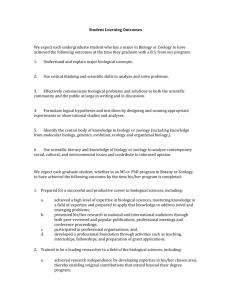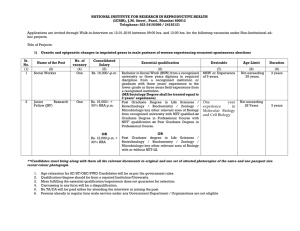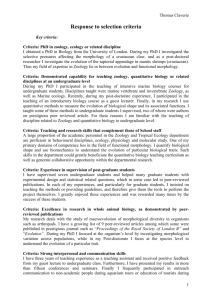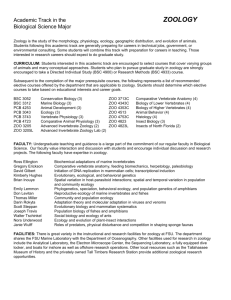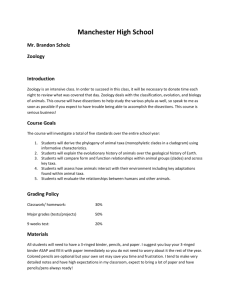Zoology - University of Tasmania
advertisement
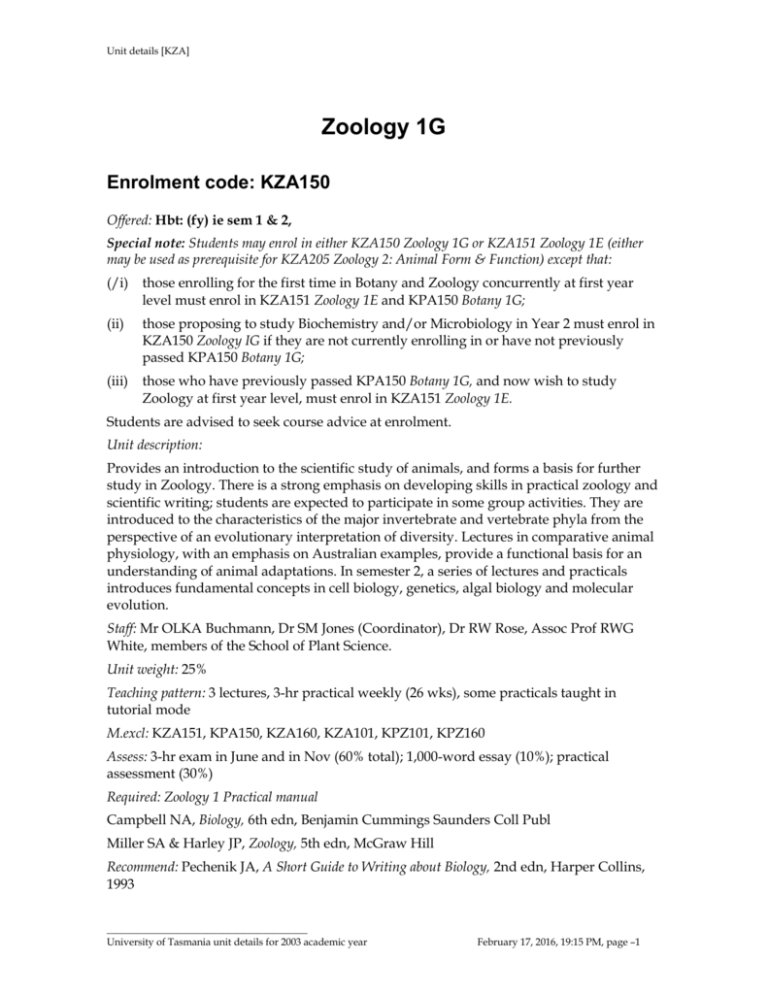
Unit details [KZA] Zoology 1G Enrolment code: KZA150 Offered: Hbt: (fy) ie sem 1 & 2, Special note: Students may enrol in either KZA150 Zoology 1G or KZA151 Zoology 1E (either may be used as prerequisite for KZA205 Zoology 2: Animal Form & Function) except that: (/i) those enrolling for the first time in Botany and Zoology concurrently at first year level must enrol in KZA151 Zoology 1E and KPA150 Botany 1G; (ii) those proposing to study Biochemistry and/or Microbiology in Year 2 must enrol in KZA150 Zoology IG if they are not currently enrolling in or have not previously passed KPA150 Botany 1G; (iii) those who have previously passed KPA150 Botany 1G, and now wish to study Zoology at first year level, must enrol in KZA151 Zoology 1E. Students are advised to seek course advice at enrolment. Unit description: Provides an introduction to the scientific study of animals, and forms a basis for further study in Zoology. There is a strong emphasis on developing skills in practical zoology and scientific writing; students are expected to participate in some group activities. They are introduced to the characteristics of the major invertebrate and vertebrate phyla from the perspective of an evolutionary interpretation of diversity. Lectures in comparative animal physiology, with an emphasis on Australian examples, provide a functional basis for an understanding of animal adaptations. In semester 2, a series of lectures and practicals introduces fundamental concepts in cell biology, genetics, algal biology and molecular evolution. Staff: Mr OLKA Buchmann, Dr SM Jones (Coordinator), Dr RW Rose, Assoc Prof RWG White, members of the School of Plant Science. Unit weight: 25% Teaching pattern: 3 lectures, 3-hr practical weekly (26 wks), some practicals taught in tutorial mode M.excl: KZA151, KPA150, KZA160, KZA101, KPZ101, KPZ160 Assess: 3-hr exam in June and in Nov (60% total); 1,000-word essay (10%); practical assessment (30%) Required: Zoology 1 Practical manual Campbell NA, Biology, 6th edn, Benjamin Cummings Saunders Coll Publ Miller SA & Harley JP, Zoology, 5th edn, McGraw Hill Recommend: Pechenik JA, A Short Guide to Writing about Biology, 2nd edn, Harper Collins, 1993 ________________________________________ University of Tasmania unit details for 2003 academic year February 17, 2016, 19:15 PM, page –1 Unit details [KZA] Disecting kit, laboratory coat Majors: Marine, Freshwater and Antarctic Biology Courses: [S3G] [S3T] Faculty website: <www.utas.edu.au/scieng/> Zoology 1E Enrolment code: KZA151 Offered: Hbt: (fy) ie sem 1 & 2, Special note: Students may enrol in either KZA150 Zoology 1G or KZA151 Zoology 1E (either may be used as prerequisite for KZA205 Zoology 2: Animal Form & Function) except that: (/i) those enrolling for the first time in Botany and Zoology concurrently at first year level must enrol in KZA151 Zoology 1E and KPA150 Botany 1G; (ii) those proposing to study Biochemistry and/or Microbiology in Year 2 must enrol in KZA150 Zoology IG if they are not currently enrolling in or have not previously passed KPA150 Botany 1G; (iii) those who have previously passed KPA150 Botany 1G, and now wish to study Zoology at first year level, must enrol in KZA151 Zoology 1E. Students are advised to seek course advice at enrolment. Unit description: Provides an introduction to the scientific study of animals, and forms a basis for further study in Zoology. There is a strong emphasis on developing skills in practical zoology and scientific writing. Students are expected to participate in some group activities. They are introduced to the characteristics of the major invertebrate and vertebrate phyla from the perspective of an evolutionary interpretation of diversity. Lectures in comparative animal physiology, with an emphasis on Australian examples, provide a functional basis for an understanding of animal adaptations. In semester 2, a series of lectures and practicals introduces fundamental concepts in animal and plant ecology, animal behaviour and experimental design. Staff: Mr OLKA Buchmann, Dr M Hindell, Dr SM Jones (Coordinator), Assoc Prof AMM Richardson, Dr RW Rose, members of the School of Plant Science. Unit weight: 25% Teaching pattern: 3 lectures, 3-hr practical weekly (26 wks), some practicals taught in tutorial mode M.excl: KZA150, KPA151, KZA160, KZA101, KZA105, KPZ101, KPZ160 Assess: 3-hr exam in June and in Nov (60% total); 1,000-word essay (10%); practical assessment (30%) Required: Zoology 1 Practical manual ________________________________________ University of Tasmania unit details for 2003 academic year February 17, 2016, 19:15 PM, page –2 Unit details [KZA] Miller SA & Harley JP, Zoology, 5th edn, McGraw Hill Augee ML, Biology of Australia and New Zealand, Benjamin Cummings Recommend: Pechenik JA, A Short Guide to Writing about Biology, 2nd edn, Harper Collins, 1993 Disecting kit, laboratory coat Majors: Marine, Freshwater and Antarctic Biology Courses: [S3G] [S3Gc1] [S3Gc2] [S3Gc3] [S3T] Faculty website: <www.utas.edu.au/scieng/> Zoology for Agricultural Science Enrolment code: KZA160 Offered: Hbt: sem 1, Special note: restricted to students enrolled in Bachelor of Agricultural Science, Bachelor of Applied Science (Agriculture), or Bachelor of Applied Science (Horticulture). Unit description: Provides an introduction to the scientific study of animals. There is a strong emphasis on developing skills in practical zoology and scientific writing; students are expected to participate in some group activities. They are introduced to the characteristics of the major invertebrate and vertebrate phyla from the perspective of an evolutionary interpretation of diversity. Lectures in comparative animal physiology, with an emphasis on Australian examples, provide a functional basis for an understanding of animal adaptations. Staff: Mr OLKA Buchmann, Dr SM Jones (Coordinator), Dr RW Rose Unit weight: 12.5% Teaching pattern: 3 lectures and 3-hr practical weekly (13 wks) Coreq: KPA160 M.excl: KZA150, KZA151, KZA101, KZA105, KPZ101, KPZ160 Assess: 3-hr exam (60%), practical assessment (40%) Required: Zoology 1 Practical Manual Miller SA & Harley JP, Zoology, 5th edn, McGraw Hill Recommend: Pechenik JA, A Short Guide to Writing about Biology, 2nd edn, Harper Collins, 1993 Disecting kit, laboratory coat Courses: [S3A] [S3B] [S3C] Faculty website: <www.utas.edu.au/scieng/> ________________________________________ University of Tasmania unit details for 2003 academic year February 17, 2016, 19:15 PM, page –3 Unit details [KZA] Zoology for Biotechnology 1 Enrolment code: KZA170 Offered: Hbt: sem 1, Special note: this unit is only offered to BBiotech students. Unit description: Provides an introduction to the scientific study of animals. There is a strong emphasis on developing skills in practical zoology and and scientific writing; students are expected to participate in some group activities. They are introduced to the characteristics of the major invertebrate and vertebrate phyla from the perspective of an evolutionary interpretation of diversity. Lectures in comparative animal physiology, with an emphasis on Australian examples, provide a functional basis for an understanding of animal adaptations. Staff: Mr OLKA Buchmann, Dr SM Jones (Coordinator), Dr RW Rose Unit weight: 12.5% Teaching pattern: 3 lectures and 3-hr practical weekly (13 wks) M.excl: KZA150, KZA151, KZA101, KZA105, KPZ101, KK160, KZA160 Assess: 3-hr exam (60%), practical assessment (40%) Required: Zoology 1 Practical Manual Miller SA & Harley JP, Zoology, 5th edn, McGraw Hill Recommend: Pechenik JA, A Short Guide to Writing about Biology, 2nd edn, Harper Collins, 1993 Courses: [S3V] Faculty website: <www.utas.edu.au/scieng/> Zoology 2: Animal Form & Function Enrolment code: KZA205 Offered: Hbt: (fy) ie sem 1 & 2, Special note: students intending to enrol in any zoology unit at level 300 must enrol in KZA205 Unit description: Provides a broad training in fundamental aspects of zoology and forms an essential basis for specialist studies at level 3. The unit focuses on developing students’ understanding of general ecology and functional anatomy from an evolutionary perspective. Lectures cover: adaptive radiation; life cycles; ecological principles; the comparative physiology of respiration, excretion and osmoregulation; and food acquisition strategies. Practical classes aim to develop skills in observation, animal identification, data collection and analysis, ________________________________________ University of Tasmania unit details for 2003 academic year February 17, 2016, 19:15 PM, page –4 Unit details [KZA] oral and written communication, and an appreciation of the comparative approach to the study of anatomical and physiological adaptations in animals. The practical format will be varied, involving some independent learning activities, and students will be required to participate in some group work. Staff: Dr LA Barmuta, Mr OLKA Buchmann (Coordinator), Dr MA Hindell, Dr C McArthur, Assoc Prof DA Ritz, Dr RW Rose, Assoc Prof R Swain Unit weight: 25% Teaching pattern: 2x1-hr lectures, 4-hr practical weekly (26 wks) Prereq: KZA150 or KZA151 or [KZA101 and (KPZ160 or KPZ101)] M.excl: KLA313 Assess: end-of-sem 1, 3-hr theory exam (20%), sem 1 assignments (30%), end-of-sem 2 3-hr theory exam (20%), sem 2 assignments (30%) Required: Barnes RSK, Calow P & Olive PJW, The Invertebrates – A New Synthesis, Blackwell Scientific Zoology 2: Animal Form and Function Practical Manual Either Willmer P, Stone G & Johnston I, Environmental Physiology of Animals, Blackwell Scientific or Eckert R, Animal Physiology – Mechanisms and Adaptations, 3rd edn, Freeman Recommend: Pechenik JA, A Short Guide to Writing about Biology, 2nd edn, Harper Collins, 1993 Disecting kit, laboratory coat Majors: Marine, Freshwater and Antarctic Biology Courses: [S3G] [S3Gc1] [S3Gc2] [S3Gc3] [S3T] Faculty website: <www.utas.edu.au/scieng/> Tasmanian Fauna: Ecological & Evolutionary Studies Enrolment code: KZA215 Offered: Hbt: sem 1, Unit description: Tasmania has a distinctive fauna in both Australian and world terms. This unit aims to provide an overview of Tasmanian habitats and the faunas they support, and to use them to illustrate a range of ecological and evolutionary principles. The unit deals with a series of habitats that are particularly well-developed in Tasmania, such as streams, lakes, sedgelands, caves and the alpine zone, and describes some of the key components of their ________________________________________ University of Tasmania unit details for 2003 academic year February 17, 2016, 19:15 PM, page –5 Unit details [KZA] fauna, including crustaceans, stoneflies, amphibians, reptiles, birds and mammals. The topics discussed include the evolution of life on land, reproduction in cold climates, life in dilute waters, Gondwanan biogeography and island endemism. The practical component will develop your familiarity with the fauna through field observations and collections, and in the laboratory the use and design of identification keys. Staff: Dr C McArthur, Assoc Prof AMM Richardson (Coordinator), Assoc Prof DA Ritz, Assoc Prof R Swain, Assoc Prof RWG White Unit weight: 12.5% Teaching pattern: 2x1-hr lectures, 4-hr practical weekly (13 wks), 2-day excursion Prereq: KZA150 or KZA151 or [KZA101 and (KPZ160 or KPZ101)] Assess: end-of-sem 3-hr theory exam (30%), assignments (70%) Required: Tasmanian Fauna Practical Manual Majors: Marine, Freshwater and Antarctic Biology Courses: [S3G] [S3Gc1] [S3Gc2] [S3Gc3] [S3T] Faculty website: <www.utas.edu.au/scieng/> Evolution, Ecology & Society Enrolment code: KZA225/325 Offered: Hbt: sem 2, Unit description: Examines contemporary theories and concepts in ecology and evolutionary biology in terms of the ways that these ideas are used to inform both scientific progress and public debate. Modern zoological theories are profoundly affecting such things as the ways in which we view developmental biology, macroevolution, conservation, the impacts of introduced species and the role of Darwinism in social policy. The unit is designed to develop critical thinking and debate about selected, currently topical concepts in Zoology through a series of structured readings, self-guided research and group discussions. The emphasis is on improving skills in finding and collating scientific evidence, understanding and evaluating competing arguments, and integrating and presenting scientific arguments in a professional manner. Staff: Dr LA Barmuta (Coordinator), Prof CR Johnson, Dr SM Jones, Assoc Prof DA Ritz Unit weight: 12.5% Teaching pattern: 2x1-hr lectures, 4-hr practical/workshop weekly (13 wks) Prereq: KZA150 or KZA151 or [KZA101 and (KPZ160 or KPZ101)] Assess: assignments (100%) Required: Pechenik JA, A Short Guide to Writing about Biology, 2nd edn, Harper Collins, 1993. ________________________________________ University of Tasmania unit details for 2003 academic year February 17, 2016, 19:15 PM, page –6 Unit details [KZA] Evolution, Ecology & Society Course Manual Recommend: reading lists to be provided with course material Majors: Marine, Freshwater and Antarctic Biology Courses: [S3G] [S3Gc1] [S3Gc2] [S3Gc3] [S3T] Faculty website: <www.utas.edu.au/scieng/> Antarctic Ecology Enrolment code: KZA351 Offered: Hbt: sem 2, Unit description: Provides a comprehensive understanding of the Antarctic marine ecosystem. The unit covers several key areas, such as the basic oceanographic features of the region and how these influence the distribution and abundance of nutrients, the role of microorganisms in the nutrient cycle, phytoplankton and their role in the food web, zooplankton communities, fish and squid communities and the role of marine mammals and seabirds. The unit also deals with the unique adaptations required by Antarctic organisms to enable them to exist in a highly adverse environment. The growing importance of resource management for the Southern ocean and the past and present history of exploitation of marine resources is also covered. Staff: Assoc Prof DA Ritz, Dr MA Hindell (Coordinator) Unit weight: 12.5% Teaching pattern: 2x1-hr lectures, 4-hr practical weekly Prereq: KZA205 Assess: practical reports (40%), essay (20%), 2-hr exam in Nov (40%) Majors: Marine, Freshwater and Antarctic Biology Courses: [S3G] [S3Gc2] [S3T] Faculty website: <www.utas.edu.au/scieng/> Environmental Adaptation Enrolment code: KZA352 Offered: Hbt: sem 2, Unit description: ________________________________________ University of Tasmania unit details for 2003 academic year February 17, 2016, 19:15 PM, page –7 Unit details [KZA] Examines the interface between ecology and physiology in the study of adaptation and provides a basis for honours projects in this area. Examples and practical experiences cover a wide range of organisms. The unit introduces a variety of data collection techniques. It aims to develop competence in practical and analytical skills, to develop skills in communication, and to develop an appreciation of ethical considerations in research which uses animals. The unit considers the following topics: environmental endocrinology; thermal adaptations in ectotherms; the evolution of endothermy and metabolic responses in endotherms; and the evolutionary transition from water to land. Students are expected to interact actively with staff in lectures, practical classes and projects. The unit is designed as a self-directed learning program, so many lectures are replaced by tutorials and reading assignments. Staff: Assoc Prof R Swain (Coordinator), Dr SM Jones, Dr RW Rose Unit weight: 12.5% Teaching pattern: 2x1-hr lectures, 4-hr practical weekly Prereq: KZA205 Assess: 2-hr exam (25%), 2,000-word essay (20%), lecture assignments (30%), practical project (25%) Required: Course Manual Recommend: reading lists are provided with course notes. Majors: Marine, Freshwater and Antarctic Biology Courses: [S3G] [S3T] Faculty website: <www.utas.edu.au/scieng/> Evolutionary Biology & Biogeography Enrolment code: KZA353 Offered: Hbt: sem 2, Unit description: Introduces students to current concepts in evolutionary biology, including the principles of taxonomy and systematics, and provides support for other Third Year Zoology units and a basis for Honours projects in the area. The unit deals with adaptation and natural selection, the species concept and modern taxonomic methods, phylogenetics, macroevolution and the way in which historical events and present day conditions combine to produce biogeographical patterns. The unit includes a practical component using the Tasmanian fauna. It complements most of the other third-year Zoology units. Staff: Assoc Prof AMM Richardson (Coordinator), Assoc Prof RWG White Unit weight: 12.5% ________________________________________ University of Tasmania unit details for 2003 academic year February 17, 2016, 19:15 PM, page –8 Unit details [KZA] Teaching pattern: 2x1-hr lectures, 4-hr practical weekly. A 5-day field excursion in Sept, based at Bronte Park in the Central Highlands, with equiv time deducted from practical classes during sem to compensate. Prereq: KZA205 Assess: practical report (40%), 2,000-word essay (20%), 2-hr exam in Nov (40%) Required: Ridley M, Evolution, 2nd edn, Blackwell Scientific, Oxf, 1996. Majors: Marine, Freshwater and Antarctic Biology Courses: [S3G] [S3Gc3] [S3T] Faculty website: <www.utas.edu.au/scieng/> Fisheries & Wildlife Management Enrolment code: KZA354 Offered: Hbt: sem 1, Unit description: Provides an understanding of the rationales, strategies and methodologies of the management of fish and wildlife populations. The differing approaches required for management for exploitation and conservation are discussed. Local and overseas examples are studied. The multidisciplinary approach to successful management is stressed. An introduction is provided to the use of population simulation as a predictive tool in management of fisheries and wildlife. Staff: Assoc Prof RWG White (Coordinator), Dr MA Hindell, Dr C McArthur Unit weight: 12.5% Teaching pattern: 2x1-hr lectures, 4-hr practical weekly; a 3-day field excursion Prereq: KZA205 Assess: practical reports (40%), essay (20%), 2-hr exam in June (40%) Required: Dissecting kit including fine-pointed forceps, laboratory coat Caughley G & Gunn A, Conservation Biology in Theory and Practice, Blackwell Scientific, Camb, 1996. Recommend: tba Majors: Marine, Freshwater and Antarctic Biology Courses: [S3G] [S3Gc3] [S3T] Faculty website: <www.utas.edu.au/scieng/> Freshwater Ecology ________________________________________ University of Tasmania unit details for 2003 academic year February 17, 2016, 19:15 PM, page –9 Unit details [KZA] Enrolment code: KZA355 Offered: Hbt: sem 2, Unit description: Develops the ecological and physiochemical concepts that are essential for the study of lakes, wetlands, and rivers. The unit emphasises the processes responsible for structuring populations and communities of organisms in open water and benthic habitats. Biological interactions (eg predation, competition) are covered, as well as foundation material such as the roles of lake stratification and of moving water in shaping aquatic communities. Recent advances in the practical applications of freshwater animals in biological monitoring and assessment are also presented. Staff: Dr LA Barmuta (Coordinator), Assoc Prof RWG White Unit weight: 12.5% Teaching pattern: 2x1-hr lectures, 4-hr practical weekly Prereq: KZA205 Assess: 2-hr exam in Nov (50%), essay (20%), 2 practical reports (30%) Required: Dissecting kit including fine-pointed forceps laboratory coat Gooderham J & Tsyrlin E, The Waterbug Book, CSIRO Publ, Melb, 2002 Recommend: Allan JD, Stream Ecology: Structure and Function of Running Waters, Chapman & Hall, NY. Majors: Marine, Freshwater and Antarctic Biology Courses: [S3G] [S3Gc2] [S3Gc3] [S3T] Faculty website: <www.utas.edu.au/scieng/> Marine Ecology Enrolment code: KZA356 Offered: Hbt: sem 1, Unit description: Examines the fundamental features and processes of marine systems. The influence of these processes on the ecology of marine organisms is highlighted. The following themes are developed: influences of physical and chemical variables on communities and productivity; ecology of feeding and predator–prey interactions of plankton and fish; structuring forces of benthic communities; chemical ecology; and macroalgal habitats; biogeography of the sea; invasions by introduced species; marine conservation. Practical classes include fieldwork and the design of field programs. The major part of the practical component is a high level research project conducted during a 6 day visit to Maria Island ________________________________________ University of Tasmania unit details for 2003 academic year February 17, 2016, 19:15 PM, page –10 Unit details [KZA] in the mid-semester break over Easter. This incurs a small extra charge to students. There is an equivalent number of free days during the semester to compensate. Students would find Quantitative Methods in Biology (KZA357), Antarctic Ecology (KZA351) and Freshwater Ecology (KZA355) particularly useful additional units. Staff: Assoc Prof DA Ritz (Coordinator), Prof CR Johnson Unit weight: 12.5% Teaching pattern: 2x1-hr lectures, 4-hr practical weekly; a 6-day field excursion Prereq: KZA205 Assess: 1,000-word essay (10%), seminar (10%), reports on practical assignments (30%), 3-hr exam in June (50%) Required: dissecting kit including fine-pointed forceps laboratory coat. Recommend: Reading lists are provided with course notes. Majors: Marine, Freshwater and Antarctic Biology Courses: [S3G] [S3Gc2] [S3Gc3] [S3T] Faculty website: <www.utas.edu.au/scieng/> Quantitative Methods in Biology Enrolment code: KZA357 Offered: Hbt: sem 1, Unit description: Quantitative skills are among the basic and fundamental tools of professional zoologists and other biologists. They are necessary to design their studies, analyse and interpret their data, and to assess and interpret published studies. This unit provides a solid grounding in appropriate ways to collect and analyse common types of data in biology and ecology. It emphasises hands-on, practical experience with commonly used statistical software and addresses the problems most often encountered in dealing with biological and ecological data. The unit covers basic sampling and experimental design, data analysis using standard univariate techniques (eg analysis of variance and covariance, regression, analysis of categorical data) and introduces multivariate techniques for both pattern exploration and hypothesis testing. This unit is strongly recommended for ecology and environmental science students and those considering Honours. Staff: Prof CR Johnson (Coordinator), Dr LA Barmuta Unit weight: 12.5% Teaching pattern: 2x1-hr lectures, 4-hr practical weekly Prereq: KZA205 or KPA205 or Yr-2 AgrSc unit as approved by HoS or by arrangement with HoS ________________________________________ University of Tasmania unit details for 2003 academic year February 17, 2016, 19:15 PM, page –11 Unit details [KZA] Assess: 3-hr exam in June (60%), essay (15%), practical reports (25%) Required: 3.5 in. computer diskettes Recommend: Quinn GP, Keough MK, Experimental Design and Data Analysis for Biologists, CUP, 2002 Majors: Marine, Freshwater and Antarctic Biology Courses: [S3G] [S3Gc1] [S3T] Faculty website: <www.utas.edu.au/scieng/> Reproductive Biology: Strategies and Mechanisms Enrolment code: KZA358 Offered: Hbt: sem 1, Special note: the unit involves experimentation on live vertebrate animals. Unit description: Deals broadly with reproductive processes and their control, with a focus on evolutionary trends in reproductive patterns, mating strategies, sexual selection and parental care. A comparative approach is taken and topics include sexual development and differentiation in brain and behaviour as well as competition for mates. Examples are chosen from both invertebrates and vertebrates with some emphasis on marsupials. Students would find the study of Environmental Adaptations (KZA352) complementary. Lecture notes and diagrams are provided on the web. Staff: Dr RW Rose (Coordinator), Assoc Prof R Swain, Dr SM Jones Unit weight: 12.5% Teaching pattern: 2x1-hr lectures (available on the web), 4-hr practical weekly Prereq: KZA205 Assess: 1,500-word essay (10%), practical work (30%), 3-hr exam (60%) Required: a full dissection kit, lab coat texts tba. Majors: Marine, Freshwater and Antarctic Biology Courses: [S3G] Faculty website: <www.utas.edu.au/scieng/> Zoology 4 (Honours) Full time/Part time ________________________________________ University of Tasmania unit details for 2003 academic year February 17, 2016, 19:15 PM, page –12 Unit details [KZA] Enrolment code: KZA400/401 Offered: Hbt: Special note: full-time students enrol in KZA400 (100%); part-time students in KZA401 (50%) Unit description: Intending Honours students should first consult the Honours Coordinator before the end of the final year of their undergraduate course. The Honours course starts either in the first week of February with a thesis being submitted by the end of November or in the first week of August with all requirements being completed by the end of May in the following year. The program consists of the following elements: a literature review, written and verbal exercises and a research project. Each of these has a number of teaching objectives, not all of which are assessed and used in the final award. The final award is based on an assessment of 11 objectives, six of which come from the thesis. Full information on objectives and assessment criteria are contained in a booklet which is available from the School. Staff: Dr L Barmuta (Coordinator) Unit weight: 100%/50% Prereq: BSc with major in Zoology or approved alternative, and at least a credit average in that major Assess: assignment (12%), seminar (18%), thesis (70%) Recommend: Rowntree D, Statistics Without Tears, Penguin Books, 1981. Courses: [S4E] [S6X] Faculty website: <www.utas.edu.au/scieng/> Marine, Freshwater and Antarctic Biology (Honours) Full time/Part time Enrolment code: KZA450/451 Offered: Hbt: Special note: full-time students enrol in KZA450 (100%); part-time students in KZA451 (50%) Unit description: Has the same broad objectives as KPA400/401 and KZA400/401; for details, see KPA450/451. Staff: Assoc Prof DA Ritz (Coordinator) ________________________________________ University of Tasmania unit details for 2003 academic year February 17, 2016, 19:15 PM, page –13 Unit details [KZA] Unit weight: 100%/50% Faculty website: <www.utas.edu.au/scieng/> Graduate Diploma in Science with Honours, specialising in Zoology Enrolment code: KZA500/501 Unit description: Has the same objectives as KZA400/401. Full time/part time ‘umbrella’ code. Courses: [S6X] Faculty website: <www.utas.edu.au/scieng/> ________________________________________ University of Tasmania unit details for 2003 academic year February 17, 2016, 19:15 PM, page –14
